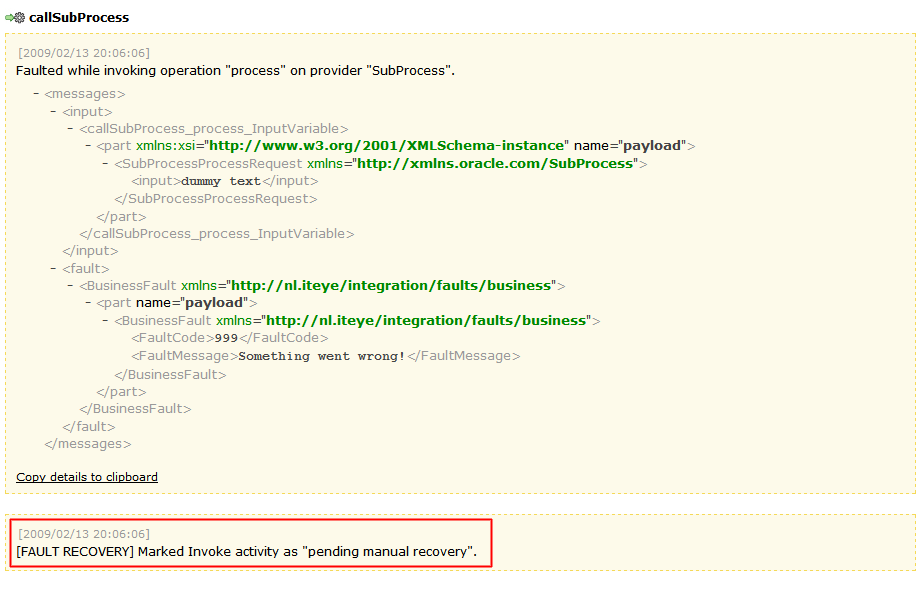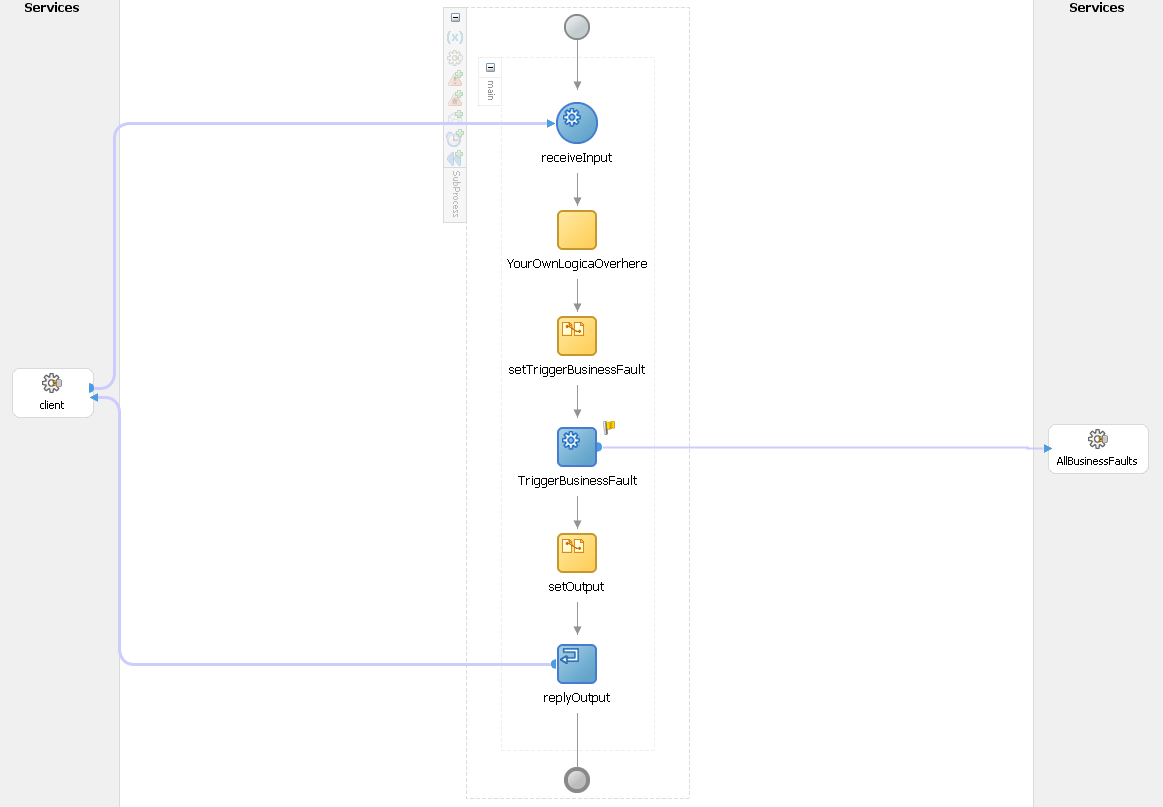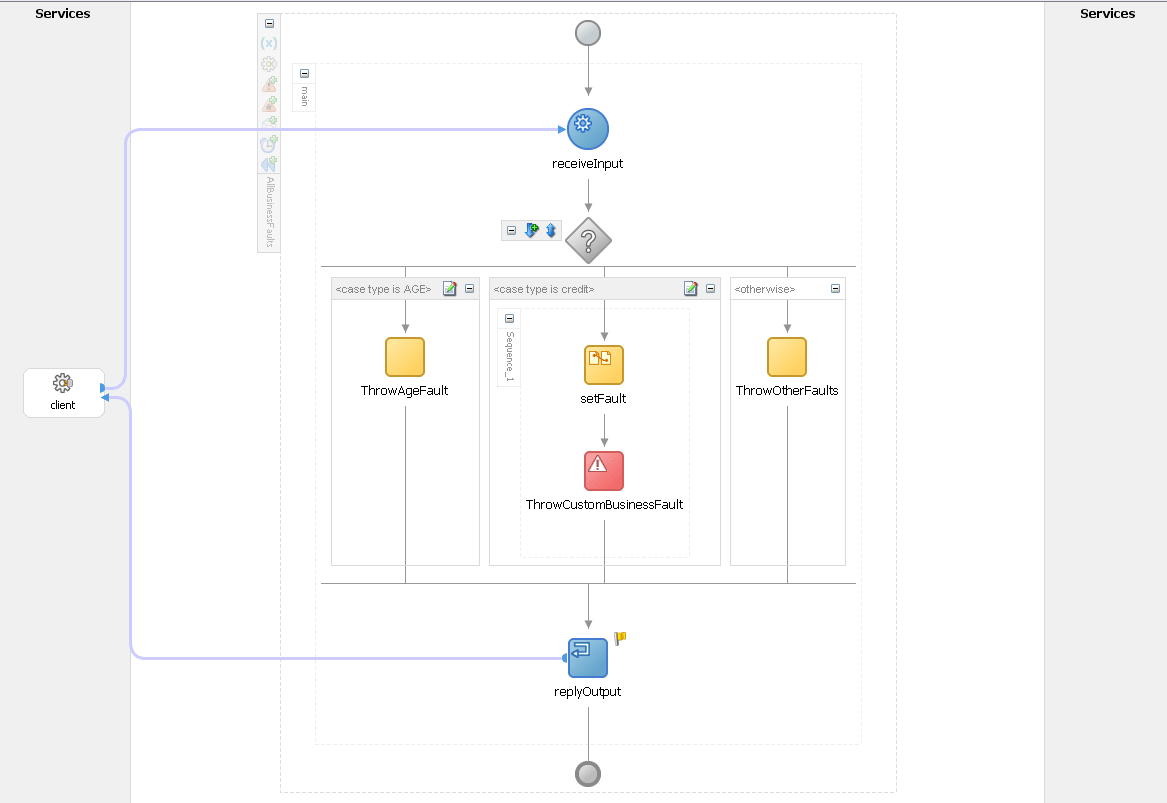rom the Oracle forum and from the comments on my article about Oracle BPEL Fault Policy Management i get a lot of questions about how to let the framework handle my own custom defined ‘business faults’.
In certain situations the default set of faults defined by Oracle aren’t suited enough and you need to define your own faults.
If we look into the examples which got supplied by Oracle we can see an example over here. In this example they defined their own NegativeCredit-fault.
The Oracle BPEL Fault Policy Framework by default only handles the faults which are getting returned on an invoke-activity.
So we have our own custom fault and the knowledge we can only let this fault getting catched by the framework by use of an invoke.
So we need atleast for this testscenario 2 bpel processes. One mainprocess which calls a subprocess, and this subprocess will throw the custom business fault.
This fault will get propogated back to the mainprocess and in here we will be able to let the framework handle the fault.

BPEL Processes
Mainprocess

Subprocess

Just a simple invoke of the subprocess from the mainprocess. The subprocess with throw a fault, and this fault will be catched in the mainprocess.
 The fault to be thrown
The fault to be thrown
From the console start the mainprocess and wait till it comes back with a fault message Click the activity to see the thrown fault
Click the activity to see the thrown fault
Ok nice!
So the custom fault we defined in the subprocess reaches the mainprocess.
Now we need to config the fault policy framework so it will get active on our custom business fault.
From the fault we pasted above we need the faultname (BusinessFault) and the namespace (http://nl.iteye/integration/faults/business).
Edit /bpel/domains/default/config/fault-policies/DefaultPolicy.xml and add the next fault :
For testing we will just let this fault getting handled by human-intervention.
Now restart the components
opmnctl stopall
opmnctl startall
Now start the mainprocess again and wait till it fails.
 It looks like the framework got active (activity yellow marked) on our custom business fault.
It looks like the framework got active (activity yellow marked) on our custom business fault.

Go to the activities-tab

And click the activity which faulted.

Now we can edit some of the values and let the subprocess get re-invoked.
So, at this moment we’re able to throw our custom business faults and let them getting catched by the framework. Since the fault is only getting catched on the invoke of a partnerlink, we aren’t able to let our custom business fault getting throwned to the process in which we maybe want do something with the data for which we actually throwed the custom business fault. So maybe we want to stay in the subprocess and somehow get the custome business fault thrown inhere, let the framework catch it and update the values of this subprocess with new values an re-execute the subprocess.
The next solution will get this done.
The mainprocess won’t get changed but in the subprocess we will invoke a new process called AllBusinessFaults.
New subprocess 2

AllBusinessFaults

The AllBusinessFaults will throw the custom business fault we ‘request’ back on the invoke in this subprocess. Now it wil get catched by the framework and we will be able to change the values of the subprocess instead of the mainprocess.

By using the AllBusinessFaults bpel service like a sort of composite service, we can add the custom business faults in it and throw the one we would like to get thrown. This will work if the collection of custom business faults isn’t that big. I’m sure there will be better solutions for this, but for the scenario i wanted to describe inhere it was good enough for me.
Question
In the examples i provided i don’t use the fault-part of a synchronous invoke to propegate the soap-fault back to the caller, i just throw the fault. The bpel engine itself throws the fault back to the first-level. Whats best practice on this one ?
Sources
BPEL Sources (First part of article with mainprocess/subprocess)
BPEL Sources (Second part of article with mainprocess/subprocess/allbusinessfaults)
Resources
Oracle BPEL 10.1.3.3 Fault Policy Management
In certain situations the default set of faults defined by Oracle aren’t suited enough and you need to define your own faults.
If we look into the examples which got supplied by Oracle we can see an example over here. In this example they defined their own NegativeCredit-fault.
The Oracle BPEL Fault Policy Framework by default only handles the faults which are getting returned on an invoke-activity.
So we have our own custom fault and the knowledge we can only let this fault getting catched by the framework by use of an invoke.
So we need atleast for this testscenario 2 bpel processes. One mainprocess which calls a subprocess, and this subprocess will throw the custom business fault.
This fault will get propogated back to the mainprocess and in here we will be able to let the framework handle the fault.

BPEL Processes
Mainprocess

Subprocess

Just a simple invoke of the subprocess from the mainprocess. The subprocess with throw a fault, and this fault will be catched in the mainprocess.
 The fault to be thrown
The fault to be thrownFrom the console start the mainprocess and wait till it comes back with a fault message
 Click the activity to see the thrown fault
Click the activity to see the thrown fault01.[2009/02/13 16:24:41]02."{http://nl.iteye/integration/faults/business}BusinessFault" has been thrown.03. 04.<businessFault xmlns="http://nl.iteye/integration/faults/business">05.<part name="payload">06.<businessFault xmlns="http://nl.iteye/integration/faults/business">07.<faultCode>999</faultCode>08.<faultMessage>Something went wrong!</faultMessage>09.</businessFault>10.</part>11.</businessFault>So the custom fault we defined in the subprocess reaches the mainprocess.
Now we need to config the fault policy framework so it will get active on our custom business fault.
From the fault we pasted above we need the faultname (BusinessFault) and the namespace (http://nl.iteye/integration/faults/business).
Edit /bpel/domains/default/config/fault-policies/DefaultPolicy.xml and add the next fault :
1.<faultName xmlns:flt="http://nl.iteye/integration/faults/business" name="flt:BusinessFault">2.<condition>3.<action ref="ora-human-intervention"/>4.</condition>5.</faultName>Now restart the components
opmnctl stopall
opmnctl startall
Now start the mainprocess again and wait till it fails.
 It looks like the framework got active (activity yellow marked) on our custom business fault.
It looks like the framework got active (activity yellow marked) on our custom business fault.
Go to the activities-tab
And click the activity which faulted.

Now we can edit some of the values and let the subprocess get re-invoked.
So, at this moment we’re able to throw our custom business faults and let them getting catched by the framework. Since the fault is only getting catched on the invoke of a partnerlink, we aren’t able to let our custom business fault getting throwned to the process in which we maybe want do something with the data for which we actually throwed the custom business fault. So maybe we want to stay in the subprocess and somehow get the custome business fault thrown inhere, let the framework catch it and update the values of this subprocess with new values an re-execute the subprocess.
The next solution will get this done.
The mainprocess won’t get changed but in the subprocess we will invoke a new process called AllBusinessFaults.
New subprocess 2

AllBusinessFaults

The AllBusinessFaults will throw the custom business fault we ‘request’ back on the invoke in this subprocess. Now it wil get catched by the framework and we will be able to change the values of the subprocess instead of the mainprocess.
By using the AllBusinessFaults bpel service like a sort of composite service, we can add the custom business faults in it and throw the one we would like to get thrown. This will work if the collection of custom business faults isn’t that big. I’m sure there will be better solutions for this, but for the scenario i wanted to describe inhere it was good enough for me.
Question
In the examples i provided i don’t use the fault-part of a synchronous invoke to propegate the soap-fault back to the caller, i just throw the fault. The bpel engine itself throws the fault back to the first-level. Whats best practice on this one ?
Sources
BPEL Sources (First part of article with mainprocess/subprocess)
BPEL Sources (Second part of article with mainprocess/subprocess/allbusinessfaults)
Resources
Oracle BPEL 10.1.3.3 Fault Policy Management


No comments:
Post a Comment